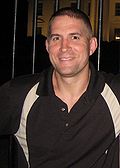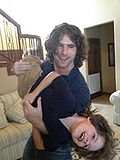People
Contents
Site Administrators
Dr. Matthew Patitz
Matt is an assistant professor of Computer Science and Computer Engineering at the University of Arkansas. He graduated with his PhD in Computer Science from Iowa State University in May 2010, and was an assistant professor of Computer Science at the University of Texas-Pan American from the fall of 2010 through the spring of 2012.
Matt's research interests focus mainly on self-assembling and self-organizing systems which display complexity arising from simple components and local interactions. There are many examples in the natural world of both living and non-living systems in which large numbers of small, autonomous pieces form systems that are extremely complex without any centralized control and from simple sets of rules. By studying existing systems and designing novel ones, he hopes to help illuminate fundamental properties of such systems which give rise to their complex behavior, including life. Additionally, the creation of complex artificial systems which self-assemble and self-organize could help to revolutionize many areas of technology.
Page: Homepage
Jacob Hendricks
Jacob is a PhD student in Computer Science at the University of Arkansas. He is a research assistant to Dr. Matthew Patitz and is studying algorithmic self-assembly.
Jacob's interests are in the study of effective systems in which simple local interactions lead to complex global behaviors and/or structures, particularly in the areas of algorithmic self-assembly and cellular automata.
Page: Homepage
Trent Rogers
Trent is a BS student in Mathematics at the University of Arkansas. He is a research assistant to Dr. Matthew Patitz.
Trent's research is focused on algorithmic self-assembly. Through self-assembling systems, we are able to appreciate and better understand the elegance and simplicity that nature uses to create the complex and chaotic natural world around us. Studying self-assembling systems does not only gives us a glimpse into the intricacies of our world, but also allows us the ability to create innovative technologies.
Page: Homepage
Tyler Fochtman
Tyler is a Masters student in Computer Science at the University of Arkansas. He is a research assistant to Dr. Matthew Patitz.
Page: Homepage
Contributors
Dr. Scott Summers
Scott is an assistant professor of Computer Science at the University of Wisconsin--Oshkosh. Scott received his BS in Computer Science from the University of Wisconsin--Green Bay in 2004 and an MS and PhD in Computer Science from Iowa State University in 2007 and 2010, respectively. Scott was previously an assistant professor of Computer Science at the University of Wisconsin--Platteville in the department of Computer Science and Software Engineering from 2010 to 2013.
Scott's currently interested in researching theoretical Computer Science, in general, and the theory of tile self-assembly, specifically.
Page: Homepage
Past Contributors
Dr. Robert Schweller
Robbie is an associate professor of Computer Science at the University of Texas-Pan American. Robbie received his Ph.D. in Computer Science from Northwestern University in June 2007 and his B.A. in Mathematics from Carleton College in June 2001.
Robbie's general research area is the design and analysis of algorithms. More specific interests include the algorithmic self-assembly of DNA, tile self-assembly, algorithmic nanotechnology, combinatorial code word design, graph labeling, anomaly/intrusion detection over network data streams, and bioinformatics.
Page: Homepage
Xingsi Zhong (Winston Zhong)
Xingsi is now a graduate student in Department of Computer Science,UTPA.
He is now a research assistant of Dr. Robert Schweller and Dr. Matthew Patitz, and doing research in algorithmic DNA self-assembly.
Page: Homepage


